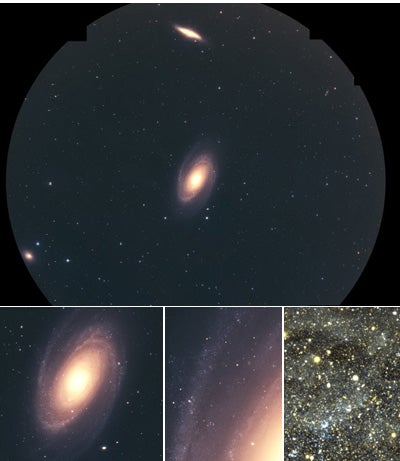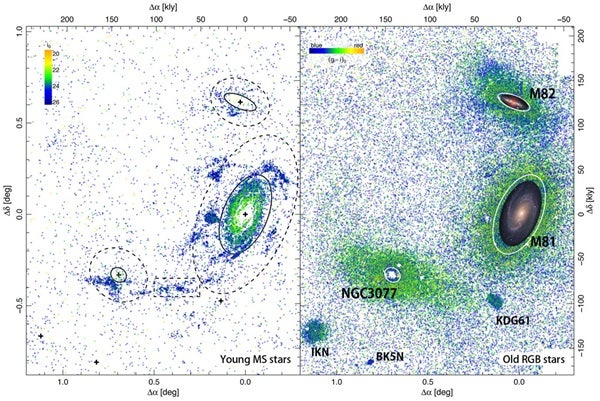Cosmological archaeological studies such as this one help astronomers refine their understanding of galaxy formation and evolution. The currently favored cosmological galaxy models are based on the idea of hierarchical structure formation: that structures in the universe such as galaxies develop from small “overdensities” to become large-scale objects. For example, the Milky Way and M81 first formed as part of a local overdensity in the primordial matter distribution — that is, the earliest accumulations of matter in the young universe. They grew over time via the agglomeration of numerous smaller building blocks, some of which may have survived later mergers to become present-day dwarf satellite galaxies. Establishing the presence and nature of these satellites, and determining the large-scale structure and stellar content of halos in spiral galaxies, is essential to understand and explain the physics of hierarchical galaxy assembly.
Over the last decade, astronomers doing large photometric surveys — that is, measuring the light intensities of celestial objects — have found a number of new satellite galaxies, stellar streams, and overdensities around the Milky Way and Andromeda galaxies. The detailed properties of stars in these systems are studied to reconstruct the stellar contents of galaxies in the early stage, which is called “galactic archeology” or “near-field cosmology.” For the galactic archeology study, it is necessary to resolve individual stars in a galaxy and observe across a good fraction of the galaxy’s radius.
Until now, the outskirts of the Milky Way and Andromeda are the only places that have been surveyed to sufficiently faint depths to enable detailed tests of the hierarchical galaxy assembly process across wide scales.
The observing team started the M81 archeology study by using Hyper Suprime-Cam (HSC). M81, also known as Bode’s Galaxy, is located at a distance of 11.7 million light-years, and is one of the nearest massive spiral galaxies similar to the Milky Way. The super-wide field of view of the HSC allowed the team to observe out to a projected radius of a half-million light-years from the center of M81. The field includes 18 known member galaxies of the M81 group in only seven pointings. The camera’s high sensitivity enabled the team to observe vast numbers of old red giant branch (RGB) stars as well as young main-sequence (MS) stars, red supergiants, and asymptotic giant-branch stars at the distance of M81.
The distribution of RGB stars in the right panel of Figure 2 shows that the extended stellar halos of the three main galaxies overlap each other and that the outer regions of M82 and NGC 3077 are highly perturbed. This is likely a consequence of the recent gravitational encounter.
The color of each point in the figure is a rough proxy for metallicity. The RGB stars in M82’s outer halo have significantly bluer colors, showing that they are more metal-poor than those in M81, the NGC 3077 halo, and the inner halo of M82. The satellite galaxies, KDG 61, BK5N, and IKN cannot be seen in the maps of young stars, but appear as overdensities of old populations in the right panel. This implies they are not the product of the recent interaction between M81, M82, and NGC 3077.
Team member Sakurako Okamoto from the Shanghai Astronomical Observatory commented on this program: “Our deep panoramic view of the M81 group demonstrates that the complexity long known to be present in neutral hydrogen (HI) is equally matched in the low-surface-brightness stellar component. Together with the galactic archeology study based on the HSC wide-field survey of the Subaru Strategic Program, we hope to establish the presence and nature of satellite galaxies, and determine the large-scale structure and stellar content of halos of spiral galaxies in general.”











